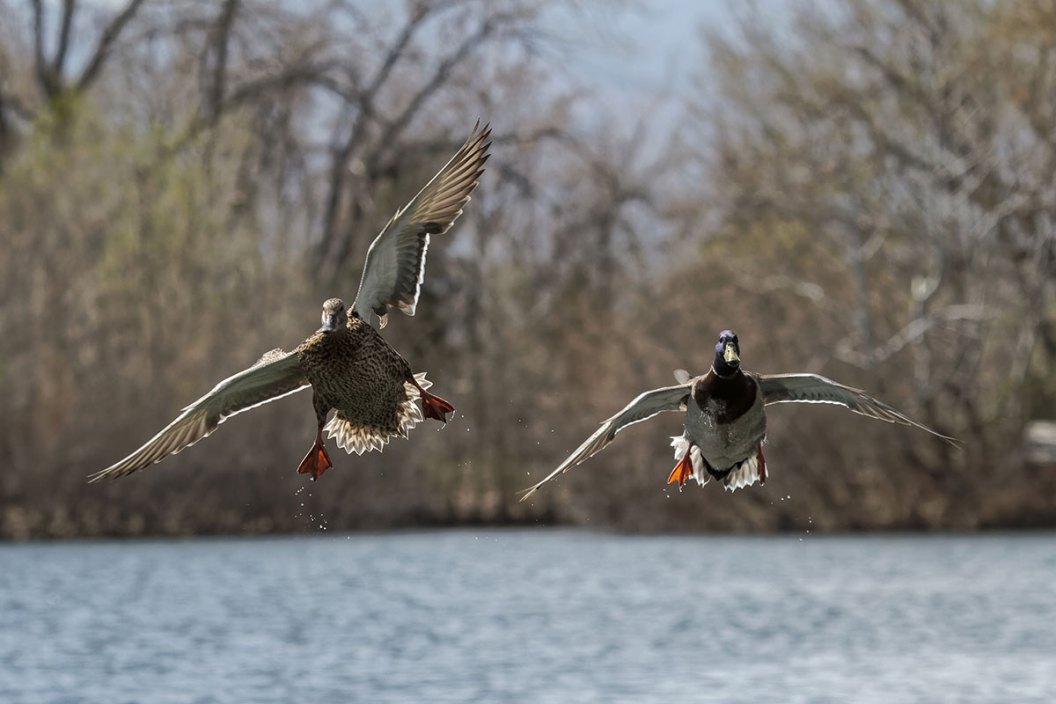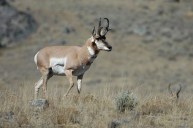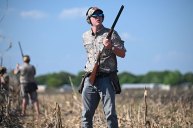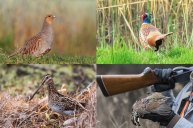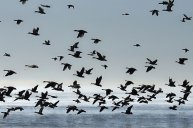Here's what you've always wanted to know about the four migratory bird flyways of North America.
There are four significant migratory bird flyways in North America: the Pacific Flyway, the Central Flyway, the Mississippi Flyway, and the Atlantic Flyway.
These are the routes by which every single migratory game bird species, including some that we cannot hunt, travels to and from their summer breeding grounds.
In the far eastern portion of North America, the Atlantic Flyway strictly hugs the coastal states, (we'll list them all later) and in the west, the Pacific Flyway stretches from Alaska to Baja California and into Mexico.
The combined governments of the United States, Canada, and Mexico, by authority of treaties and federal legislation, have assumed the ultimate responsibility for the protection and conservation of migratory birds in North America. In the United States, this duty has largely been delegated to the U.S. Fish and Wildlife Service.
USFWS and its partners manage migratory birds based on the routes the birds follow as they migrate between nesting and wintering areas.
After several years of working in the overall flyway system, the individual states decided that they could more effectively achieve their objectives by organizing as independent flyways rather than operating individually, and in 1951 the Association of Fish and Wildlife Agencies recommended just that.
Now, migratory bird hunters are contributing to a vast and proud tradition of wildlife conservation. Revenues from hunting licenses and excise taxes on hunting-related equipment have funded wildlife research, wildlife management, and habitat acquisition and restoration for nearly 100 years.
More specifically, duck stamps are sold in the United States as a requirement for anyone wanting to hunt most migratory game birds, and further support the conservation and habitat efforts.
Let's take a closer look at the migratory bird flyways so we can gain a better understanding overall.
What is a Flyway?
Simply put, migratory birds are creatures of habit. They follow the same or similar ancient routes every year for their annual migration south towards warmer weather and available food in the winter, and back up north to breed for the warmer spring and summer months.
A flyway is the path these species of birds, particularly game birds, take on their annual journey.
By assigning each a zone with specific borders, the states or provinces included can then conduct research, band birds, and share the informational resources with each other to better understand bird movement and breeding success.
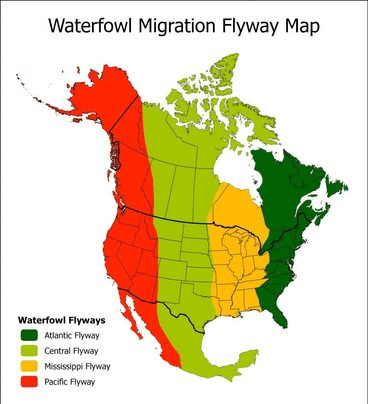
National Wildlife Refuge Association
Geography plays a key role in the flyway system, as many species are specific to certain regions of the U.S. and Canada, continuing south to Mexico and beyond. Of course, there is species-by-species overlap in the flyways; as an example, the common mallard duck is present in all four of the major flyways.
Pacific Flyway
The common border between the Pacific Flyway and the Central Flyway is the only region among the four that doesn't follow specific border-by-border state or province lines on the map. Nonetheless, the ducks and geese that we hunt in the Pacific Flyway during the year couldn't care less.
To make up the Pacific Flyway, the U.S. states include Alaska, Arizona, California, Idaho, Nevada, Oregon, Utah, Washington, and the portions of Colorado, Montana, New Mexico, and Wyoming west of the Continental Divide. Across the border in Canada, this includes the provinces of British Columbia and the Yukon.
Game Birds of the Pacific Flyway
There are so many species that can be found in the Pacific Flyway, and looking at the listing from the USFWS feels like reading a "who's who" of American waterfowl.
Not every bird on the list has a hunting season everywhere in the Pacific Flyway, but the ducks that do include mallards, pintails, American widgeon, green-winged teal, blue-winged teal, cinnamon teal, northern shoveler, Gadwall, wood duck, Eurasian widgeon, canvasback, redhead, ring-necked duck, lesser and greater scaup, (bluebill) bufflehead, ruddy duck, goldeneye, Barrow's goldeneye, surf scoter, white-winged scoter, black scoter, long-tailed duck, Harlequin duck, merganser, red-breasted merganser, and hooded merganser.
Hunting in the Pacific Flyway
The Pacific Flyway has a diverse collection of habitat, landscapes, and hunting locations. Everything from farm fields to saltwater tributaries to backwater sloughs can be accessed and hunted throughout the flyway, but we'll zoom in on some of the more interesting and prevalent spots.
Contrary to popular belief, Arizona has some good waterfowl hunting. Imperial, Cibola, and Havasu National Wildlife Refuges offer really good, walk-in public land hunting in the state. Reservations and draws are required, but some spots like Imperial don't get a lot of hunting pressure.
Arizona offers some good early season teal hunting followed later by decent wingshooting for wigeon, shovelers, bluebill, pintails, mallards, and ring-necked ducks. Even goose hunters can get in on the action.
We'd be remiss if we didn't mention Puget Sound, Washington as a migratory game bird hot spot. The north shore hunting on the sound is famous around waterfowling circles, but there is some good public land on the south edge as well in the Billy Frank Jr. Nisqually National Wildlife Refuge, which has decent public access.
The downside is that hunting access is by boat only; hunters may not set foot on land, and even crippled and dead birds may not be retrieved on closed areas. But this NWR does offer good hunting for puddle ducks and some of our favorite diving species, such as the Scaup.
Other places, like the Snake River in Idaho and Humboldt Bay in California, also stand as good Pacific Flyway representation.
Central Flyway
The Central Flyway has the same (somewhat) ubiquitous lines to its west that it shares with the Pacific Flyway, but it has a more obvious border to its east. As it is named, this flyway drives its way south through the mid-section of the continent straight through the heartland of the U.S. and skirting the Rocky Mountains to the west.
The Central Flyway includes the states of Montana, Wyoming, Colorado, New Mexico, Texas, Oklahoma, Kansas, Nebraska, South Dakota, and North Dakota. To the north, the Canadian provinces of Alberta, Saskatchewan and the Northwest Territories make up its northern frontier.
Game Birds of the Central Flyway
According to USFWS information, ducks in the Central Flyway include the mallard, gadwall, and American wigeon, northern pintail, northern shoveler, and wood Duck, American black duck, black-bellied whistling duck and fulvous tree duck, blue-winged teal, green-winged teal, redhead, canvasback and ring-necked duck, greater scaup, lesser scaup, common goldeneye, ruddy duck, and hooded merganser.
Add to this snow/blue geese, Ross's geese, white-fronted geese, Canada geese, and the tundra swan.
And let's not forget to mention the incredibly valued sandhill crane, mourning doves, white-winged doves, band-tailed pigeon, and the American woodcock.
Hunting in the Central Flyway
The Central Flyway is well known for so many huntable, bucket-list species and locations that it's almost not fair, but in central Kansas near Great Bend lies the Cheyenne Bottoms Wildlife Area, which has fast become one of the best waterfowl hunting destinations there is. It is one of the largest inland marshes in the United States with nearly 20,000 acres of wetlands that provide hunters with access to some of the best wingshooting around.
For those adventurous types, Saskatchewan—home of the Duck Factory—needs to be on this list as well. If you've ever been a member of Ducks Unlimited, a lifelong duck hunter, or simply a bird watcher that enjoys knowing where they all come from, then you're familiar with the term "Prairie Pothole Region."
The vastness of the region coupled with the fact that it has such a high density of wetlands makes Saskatchewan one of the premier waterfowl hunting destinations in North America. Basically speaking, get out a map of this Canadian province, close your eyes, and pick a spot. You'll easily be able to find an outfitter or even possibly a walk-in area for a duck or goose hunt.
For good measure, we wanted to mention Texas, and specifically the town of Rockport on the Gulf of Mexico, as a historically significant waterfowl hunting area. Home to what's believed to be the oldest private hunting club in the state, the region serves as a final stop for many species that travel the Central Flyway. That means the hunting opportunities, when the timing is right, can be incredibly productive.
Mississippi Flyway
The Mississippi Flyway extends from as far north as the Arctic Circle to the southern tip of Mexico. This flyway is made up of the states of Alabama, Arkansas, Indiana, Illinois, Iowa, Kentucky, Louisiana, Michigan, Minnesota, Mississippi, Missouri, Ohio, Tennessee, and Wisconsin. It also includes the Canadian provinces of Manitoba and Ontario.
As expected, it follows the flow of the Mississippi River, and encompasses a good portion of the southern United States, specifically the spots where duck hunting has a long and rich history. Nestled into this flyway are some of the greatest waterfowl hunting destinations ever created by nature.
Game Birds of the Mississippi Flyway
Ducks in the Mississippi Flyway include the venerable mallard, gadwall, and American wigeon, northern pintail, northern shoveler, and wood duck, American black duck, mottled duck, black-bellied whistling duck, blue-winged teal, green-winged teal, redhead, canvasback and ring-necked duck, greater scaup, lesser scaup, common goldeneye, ruddy duck, and hooded merganser.
Also, snow/blue geese, Ross's geese, white-fronted geese, Canada geese, and the tundra swan are frequent inhabitants of the Mississippi Flyway. This also includes most of the doves, the sandhill crane, and the inimitable woodcock.
Hunting the Mississippi Flyway
Goodness, where do we begin? Would it be the Louisiana Gulf Coast, or the Arkansas Grand Prairie? The Southern Manitoba goose factory, or a Lake Erie Canvasback hunt? The possibilities are nearly endless in this flyway.
Most migratory bird hunters would seemingly choose a bucket-list Louisiana waterfowl hunt in the bayou, but the fact remains that hunting game birds further north in Wisconsin, Illinois, or Missouri is some of the best there is.
Puddle duck hunting from the shoreline in shallow-water flats or one of the numerous public hunting marshes in these Midwestern states is tough to beat, especially in famous areas like the Harsens Island Unit of Michigan's St. Clair Flats State Wildlife Area and Fish Point State Wildlife Area.
Hunting from pit blinds in flooded agricultural fields is the name of the game in southern Missouri, and where the Mississippi River converges with the Ohio River near Cairo, Illinois, marks the northern reaches of the Mississippi Alluvial Valley, where duck hunting is king.
The choices are many in the Mississippi Flyway, and almost all provide great potential for an incredible experience.
Atlantic Flyway
Of the four flyways, only the Atlantic hugs the main eastern coastline from Nunavut and Newfoundland all the way to Puerto Rico and the U.S. Virgin Islands with only a few landlocked states in between. It appears on the map to be smaller than the other three, but they are all comparable in size.
Not only that, but the Atlantic Flyway has one statistic that outdoes the others: yearly harvest numbers. Atlantic Flyway waterfowlers bagged 1.6 million ducks and 754,000 geese back in 2017, making it the most productive duck hunting flyway in North America.
The Atlantic Flyway is composed of the U.S. states of Connecticut, Delaware, Florida, Georgia, Maine, Maryland, Massachusetts, New Hampshire, New Jersey, New York, North Carolina, Pennsylvania, Rhode Island, South Carolina, Vermont, Virginia, and West Virginia. North of the border the Canadian territory of Nunavut and provinces of Newfoundland, New Brunswick, Nova Scotia, Ontario, Prince Edward Island, and Quebec all the way to the U.S. territories of Puerto Rico and U.S. Virgin Islands.
Game Birds of the Atlantic Flyway
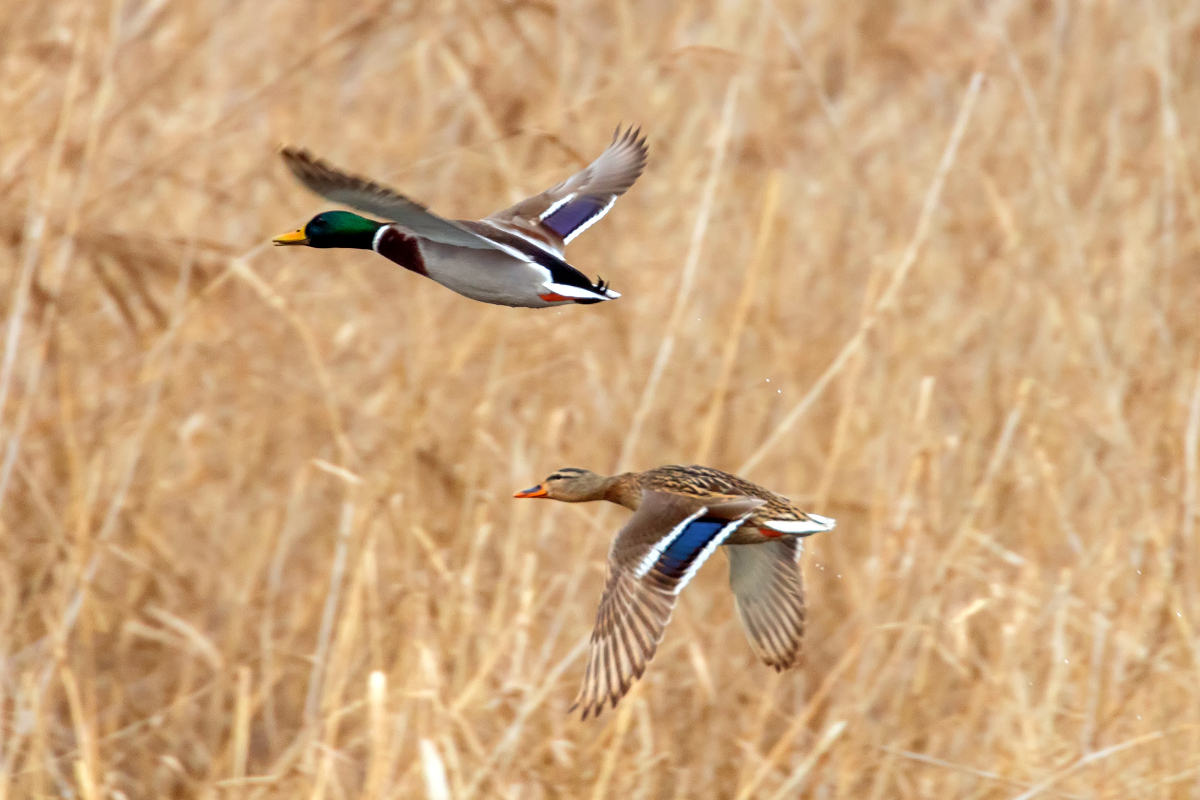
Maybe the question should be, what doesn't the Atlantic Flyway hold in the name of migratory game birds? There are typically no sandhill cranes, but transient birds are sighted yearly. Doves such as the mourning dove are residents, but not all states allow their harvest.
When it comes to waterfowl, Maine is famous for eider hunting and you'll also find scoters and long-tailed ducks on the saltwater, plus buffleheads and goldeneyes inland.
Virtually all of the puddle duck species are present, small to large including the diving breeds like scaup, canvasbacks, redhead, ring-necks, and mergansers just to name a few.
Hunting the Atlantic Flyway
The Chesapeake Bay is arguably one of the greatest waterfowl hunting destinations in the Atlantic Flyway, both in terms of its vast size—almost 4,500 square miles—and its esteemed history. This is a true bucket list place all waterfowlers need to visit once in their lifetime. Hunters could feasibly hit the back bays and marshes for puddle ducks in the morning, and then try the open bay for every conceivable diving duck in the afternoon.
Honorable mention to South Carolina's ACE Basin and its 1 million acres that include over 40,000 acres of public hunting area.
While it may seem that the emphasis in our continent's flyways is waterfowl hunting, and it is, there are many migratory game birds that use these flyways to continue the generational progress of their species, year after year after year.
Migrating birds of the North American flyways have certainly earned their spot amongst the continent's preferred game species. It's cool to think about the fact that we can hunt the same birds up north in the fall that our brother and sister hunters chase in their wintering grounds down south, and neither of us have to travel.
Learning about the different bird migration routes can teach us a lot, and North American bird conservation efforts become more organized and ultimately more effective.
Hopefully, what you learn about the migration flyways can be put to good use, and ultimately result in a limit of waterfowl each time you hunt.
Looking for a little more or even hot lunch for your hunting blind? Follow my webpage, or on Facebook and Twitter.
NEXT: 5 THINGS YOU WANT NEW HUNTERS TO TAKE AWAY FROM THE EXPERIENCE
